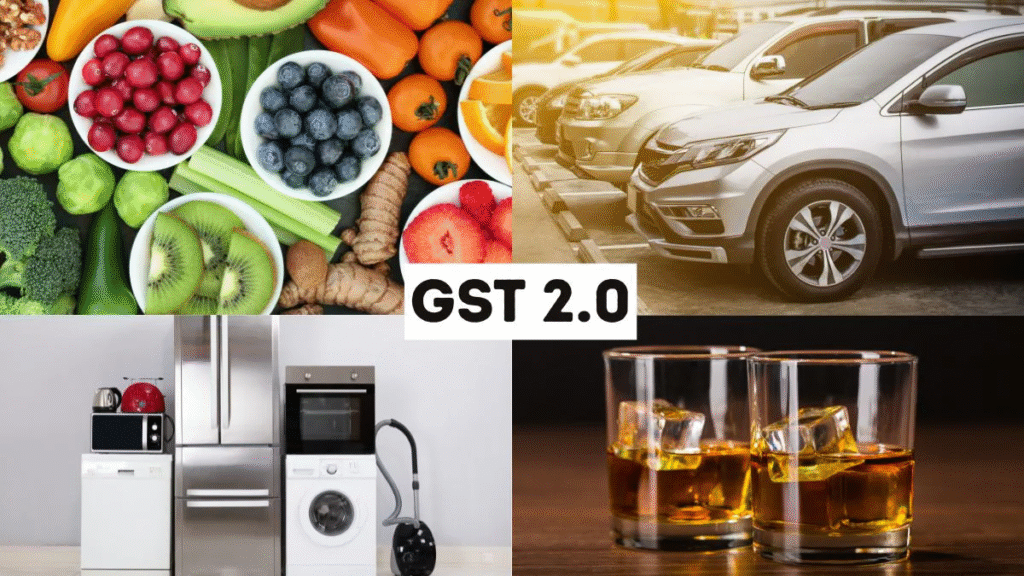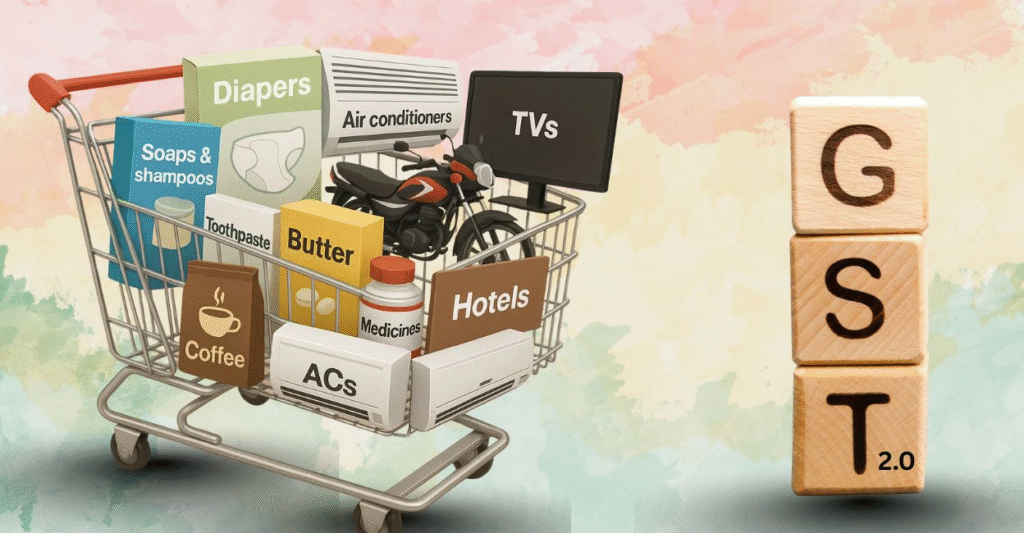Imagine walking into your favorite supermarket this Navratri and realizing that paneer, biscuits, and even your everyday shampoo suddenly cost less. No, it’s not just festive discounts. It’s the Union Government’s much-hyped GST 2.0 reform kicking in — a revamp that promises to reshape how we shop, save, and even invest.

Prime Minister Narendra Modi has called it the beginning of a “GST Savings Festival”, tying it to the spirit of Swadeshi and self-reliance. But beyond the slogans and headlines, what does GST 2.0 actually mean for you and me — the common consumer, the small business owner, and the middle-class family balancing savings with rising aspirations?
This blog will decode GST 2.0 in plain English — its impact on essentials, luxuries, businesses, and India’s broader economy. We’ll also look at what’s cheaper, what’s not, and whether this really signals the “next generation” of India’s indirect tax system.
GST 2.0: What Has Changed?
The earlier GST system had four major slabs — 5%, 12%, 18%, and 28% — plus additional cesses on certain goods. While it simplified India’s chaotic tax system compared to pre-2017, many still found it confusing.
Now, GST 2.0 merges the slabs into just two categories plus a “sin tax”:
- 5% slab → Essential goods (food items, medicines, FMCG basics)
- 18% slab → Most other goods and services
- 40% slab → Luxury and “demerit” goods like tobacco, alcohol, betting, online gaming
This structural shift is designed to:
- Reduce compliance headaches for businesses
- Pass on tangible price benefits to consumers
- Encourage consumption, especially in the middle class
- Reinforce the “Made in India” movement by boosting local production
What You Should Remember
GST 2.0 simplifies life for both buyers and sellers by reducing tax slabs. The fewer the slabs, the easier it is to understand, comply with, and track savings.
Essentials Get Cheaper: Relief for the Household Budget
If your monthly grocery bill feels like it eats away half your salary, GST 2.0 brings some relief. Everyday essentials are cheaper now because many items moved from higher slabs to 5% or nil GST.
FMCG and Food Products
- Paneer: Amul and Mother Dairy reduced prices of 200 gm packs by 3% (now ₹92).
- Milk cartons: UHT milk is cheaper by 3% — ₹75 per litre for Mother Dairy, ₹80 for Amul Gold.
- Amul butter khakra: Down to ₹95 from ₹100.
- Amul cheese onion paratha: Huge drop — ₹200 from ₹240.
Packaged Goods
- Kellogg’s cornflakes: 11% cheaper (₹355 from ₹399).
- Sunfeast Marie biscuits: 12% lower for a 1 kg pack.
- Pringles chips (107 gm): Down 12%, now ₹110.
Ice Creams
- Mother Dairy vanilla cup (50 ml): ₹9 instead of ₹10.
- Butterscotch cone (100 ml): 14% cheaper at ₹30.
Personal Care Items
- Shampoo, toothpaste, soaps, and hair oil (brands like Dove, Himalaya, Close-Up, L’Oréal) are now 11–13% cheaper.
What You Should Remember
Households will see 5–15% savings across daily essentials. For a middle-class family, this can mean thousands saved annually.
Big-Ticket Savings: Cars, Cement, and Insurance
While groceries lighten your monthly burden, GST 2.0 is equally impactful for big-ticket expenses.
Automobiles
- Maruti Suzuki cars are now cheaper by ₹46,400 to ₹1.29 lakh.
- Small cars: GST cut from 28%+cess → 18%.
- SUVs & premium cars: Still higher at 40%, but lower than earlier combined 50%.
Challenge: Dealers stuck with pre-GST 2.0 inventory suffered losses worth ₹2,500 crore due to unsold cars taxed at older rates.
Housing and Construction
- Cement: GST cut from 28% → 18%.
- All major producers like UltraTech and JK Cement promise to pass on benefits.
- Cheaper cement could lower construction costs, benefiting both homebuyers and the real estate sector.
Insurance
- Life and health insurance policies are now exempt from the earlier 18% GST.
- This means up to 15% lower premiums — a big win for families prioritizing financial security.
Durables and Appliances
- Whirlpool A/Cs: ₹4,509–₹5,259 cheaper.
- Dishwashers: ₹3,282–₹4,336 cheaper.
What You Should Remember
GST 2.0 isn’t just about daily groceries. It impacts big dreams too — from buying your first car to securing health cover to constructing a home.
The Economic Angle: Why GST 2.0 Matters Beyond Savings

Economists see GST 2.0 as more than just a festive discount drive. According to Bank of Baroda analysts, it could:
- Boost consumption: Lower prices encourage spending, especially in FMCG and autos.
- Lower inflation: With essentials taxed less, inflationary pressure reduces.
- Encourage savings & investments: Money saved can be redirected to SIPs, FDs, or gold.
- Simplify compliance: Fewer slabs → fewer disputes, less confusion for businesses.
Think of it like cricket — when overs are reduced in a rain-hit match, it’s easier to track runs and overs. GST 2.0 is India’s way of reducing “overs” in tax calculations.
What You Should Remember
Beyond your wallet, GST 2.0 may re-energize India’s consumption cycle — a key driver for GDP growth.
Challenges and Criticisms: Is GST 2.0 a Complete Solution?
No reform is without flaws. GST 2.0, while promising, has its pain points:
- Small Businesses: Many SMEs worry about accumulated unused input tax credit. Transitioning to new slabs is tricky.
- Dealers’ Losses: Auto and electronics dealers lost crores due to pre-GST 2.0 inventory.
- States’ Concerns: Opposition parties argue reforms don’t address states’ demand for extended GST compensation.
- Luxury Goods Pricing: While essentials are cheaper, luxury buyers still face high 40% rates — leading to fears of black-market growth.
Congress has accused PM Modi of “claiming sole credit” while ignoring state-level fiscal pressures.
What You Should Remember
GST 2.0 is a big step forward, but not the final destination. For true success, states’ concerns and SMEs’ struggles need resolution.
Cultural Spin: Why Launch on Navratri?
Navratri isn’t just a festival; it’s a symbol of new beginnings. By launching GST 2.0 on this auspicious day, the government is clearly tying reforms to cultural pride and emotional resonance.
- Psychology of Savings: Linking tax cuts to festivals encourages immediate spending.
- Swadeshi Mantra: Positioning GST 2.0 as a push for “Made in India” goods appeals to nationalist sentiment.
- Consumer Sentiment: Festive seasons already see high shopping activity — this timing ensures maximum impact.
What You Should Remember
GST 2.0 isn’t just economics; it’s politics and culture blended to maximize acceptance.
Final Thoughts: Will GST 2.0 Deliver on Its Promise?
For the average Indian, GST 2.0 feels like a direct win. Groceries are cheaper, cars cost less, insurance premiums drop, and even your favorite snacks are lighter on the wallet.
But beyond savings, the real test lies in implementation: Will businesses genuinely pass on benefits? Will states get their fair share? Will SMEs adapt smoothly?
For now, as you sip a slightly cheaper glass of milk this Navratri, remember — GST 2.0 is more than a tax reform. It’s India’s attempt at blending fiscal simplification with cultural timing to spark a new wave of consumption-led growth.
